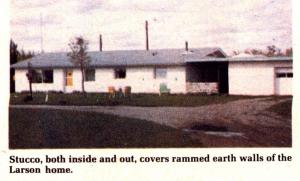1981 - Volume #5, Issue #2, Page #36
[ Sample Stories From This Issue | List of All Stories In This Issue | Print this story
| Read this issue]
Rammed Earth Makes Dirt Cheap Housing
 |
Larson, who raises 2,200 acres of grain, is still happy with the house. "It has withstood the test of time with no problems whatsoever. I'd highly recommend it as an alternative for anyone looking for a way to build a modern new house dirt cheap," Larson told FARM SHOW.
Rammed earth construction uses plain clay soil for the walls. The soil is tamped lightly to make the walls solid and self-supporting. Larson says it is similar to building with adobe or sod as some Indians and pioneers used to do. "I really see rammed earth construction as a do-it-yourself thing ù a way to beat skyrocketing construction costs by doing virtually all of the labor your-self," says Larson. It took him 8 months of spare time to build his 54 by 28 ft. (inside dimensions) earth house. The $7,000 cost included concrete footings, sewer installation and an LP-gas tank for his furnace.
The house features 18 in. thick exterior walls. Stucco covers the walls both inside and out. "You'd never know the house was made of earth to look at it," Larson notes. "The outside walls are both soundproof and fireproof."
Steel concrete reinforcing rod and barbed wire help support the outside dirt walls. The interior walls are made from lumber and sheetrock and the roof also was built from conventional materials.
"The house is very comfortable," Larson told FARM SHOW. "We don't even feel the changes in seasons. It's cool in summer and easy to heat in winter," he points out.
He built the house after seeing one in a magazine article. Since there was little information available as to how to build one, he did it on a trial basis by first building a garage "to test the idea to see if it would work."
He built his own adjustable steel forms for ramming the earth which worked out well. He tamped the earthwith a jack hammer, however, rather than doing the tamping by hand. "Using a jack hammer was a lot of work and packed the soil too much, reducing the insulating value of the dirt walls. So, when I built the house, I made a hand-powered tamping tool out of angle iron which solved the problem."
An 80,000 btu LP-gas furnace is sufficient to heat the 1,500 sq. ft. of living area in the house. There are no moisture problems and it is very strong since it weighs at least a ton per linear foot, Larson points out. The house has had no problem meeting building codes, either. "We've had several inspectors come up from Williston and none of them could find anything wrong," he notes.
Several years ago, he helped a neighbor build a two-story rambler home and he is thinking about building another rammed earth home for himself. He intends to use 24 in. thick exterior walls, and will also make the interior walls out of rammed earth.
To answer the many questions he has been asked by hundreds of visitors, Larson has put together a set of "how to" plans for building the adjustable-width rammed earth forms he designed. The plans cost $10 and include instructions and details. Larson also has published a booklet, "How to Build a Rammed Earth Home". It's available for $5.
For more information, contact: FARM SHOW Followup, Ray Larson, Route 3, Box 99, Williston, N. Dak. 58801 (ph 701 875-3621).

Click here to download page story appeared in.

Click here to read entire issue
To read the rest of this story, download this issue below or click here to register with your account number.




